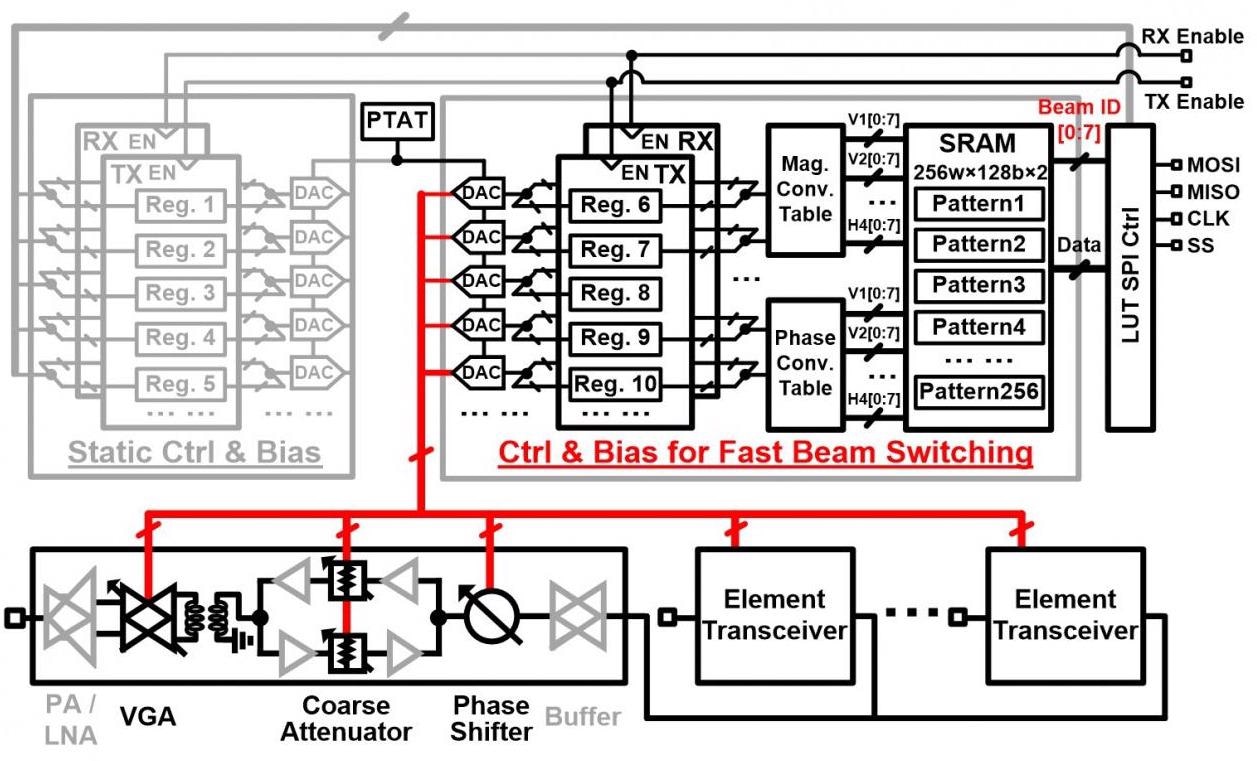Jun 14 2021
Researchers from the Tokyo Institute of Technology (Tokyo Tech) and NEC Corporation, have jointly designed a 28-GHz phased-array transceiver that assists reliable and efficient 5G communications.
 Large volume SRAM and lookup table are used for supporting 256 beam settings. The mechanism supports fast switching in transmit (TX) and receive (RX) mode with direct external TX/RX enable pins. Image Credit: 2021 Symposia on VLSI Technology and Circuits.
Large volume SRAM and lookup table are used for supporting 256 beam settings. The mechanism supports fast switching in transmit (TX) and receive (RX) mode with direct external TX/RX enable pins. Image Credit: 2021 Symposia on VLSI Technology and Circuits.
The recommended transceiver surpasses the early designs in numerous regards by adapting the mechanism of fast beam switching and leakage cancellation.
With the latest emergence of novel technologies, like smart mobility, autonomous vehicles, smart cities and the Internet of Things, the world is on the edge of a new age. This triggers the use of millimeter-wave bands, which have relatively more signal bandwidth, to accept these new concepts.
5G can provide data rates of more than 10 Gbit/second by using these millimeter-waves and multiple-in-multiple-out (MIMO) technology — a technology that uses numerous receivers and transmitters to transmit more data simultaneously.
Large-scale phased-array transceivers are vital for implementing these MIMO systems. Although MIMO systems are known to improve spectral performance, large-scale phased-array systems encounter many difficulties, like implementation costs and increased power dissipation.
One such major difficulty is latency caused by beam switching time. Beam switching is a significant feature that helps select the most optimal beam for every terminal. Therefore, a design that improves beam switching time and the cost of a device is urgently needed.
Inspired by this, the researchers from the Tokyo Institute of Technology and NEC Corporation in Japan teamed up to create a 28-GHz phased-array transceiver that supports high-speed data communication and fast beam switching. The study results will be debated at the 2021 Symposia on VLSI Technology and Circuits — an international conference that investigates innovative ideas and emerging trends in semiconductor technology and circuits.
The recommended design eases dual-polarized operation, wherein data is sent at the same time via vertical and horizontal-polarized waves. But one problem with such systems is cross-polarization leakage, which leads to signal degradation, particularly in the millimeter-wave band. The researchers explored this problem and came up with a solution.
Fortunately, we were able to devise a cross-polarization detection and cancellation methodology, using which we could suppress the leakages in both transmit and receive mode.
Kenichi Okada, Study Lead and Professor, Tokyo Institute of Technology
One crucial feature of the recommended mechanism is the potential to obtain high-accuracy beam control and low-latency beam switching. Static elements regulate the building blocks of the mechanism, whereas on-chip SRAM is used for storing the settings for different beams. This mechanism results in rapid beam switching and helps achieve ultra-low latency. It also allows rapid switching in transmit and receive modes because of the use of separate registers for each mode.
Low cost and small size are other aspects of the proposed transceiver. The transceiver consists of a bi-directional design, which enables a smaller chip size of 5 × 4.5 mm2.
For a sum of 256-pattern beam settings preserved inside the on-chip SRAM, a beam switching time of just 4 ns was obtained! Error vector magnitude (EVM) — a measure to determine the efficiency of digitally modulated signals, like quadrature amplitude modulation (QAM), was evaluated for the recommended transceiver. The transceiver was also supported with EVMs of 3.5% in 256 QAM and 5.5% in 64 QAM.
When compared to advanced 5G phased-array transceivers, the system has a more rapid beam switching time and outstanding MIMO efficiency. Okada is hopeful about the future of the 28-GHz 5G phased-array transceiver.
The technology we developed for the 5G NR network supports high-volume data streaming with low latency. Thanks to its rapid beam switching capabilities, it can be used in scenarios where enhanced multi-user perception is required. This device sets the stage for a myriad of applications, including machine connectivity and the construction of smart cities and factories.
Kenichi Okada, Study Lead and Professor, Tokyo Institute of Technology
This study was financially supported by the Ministry of Internal Affairs and Communications in Japan (JPJ000254).